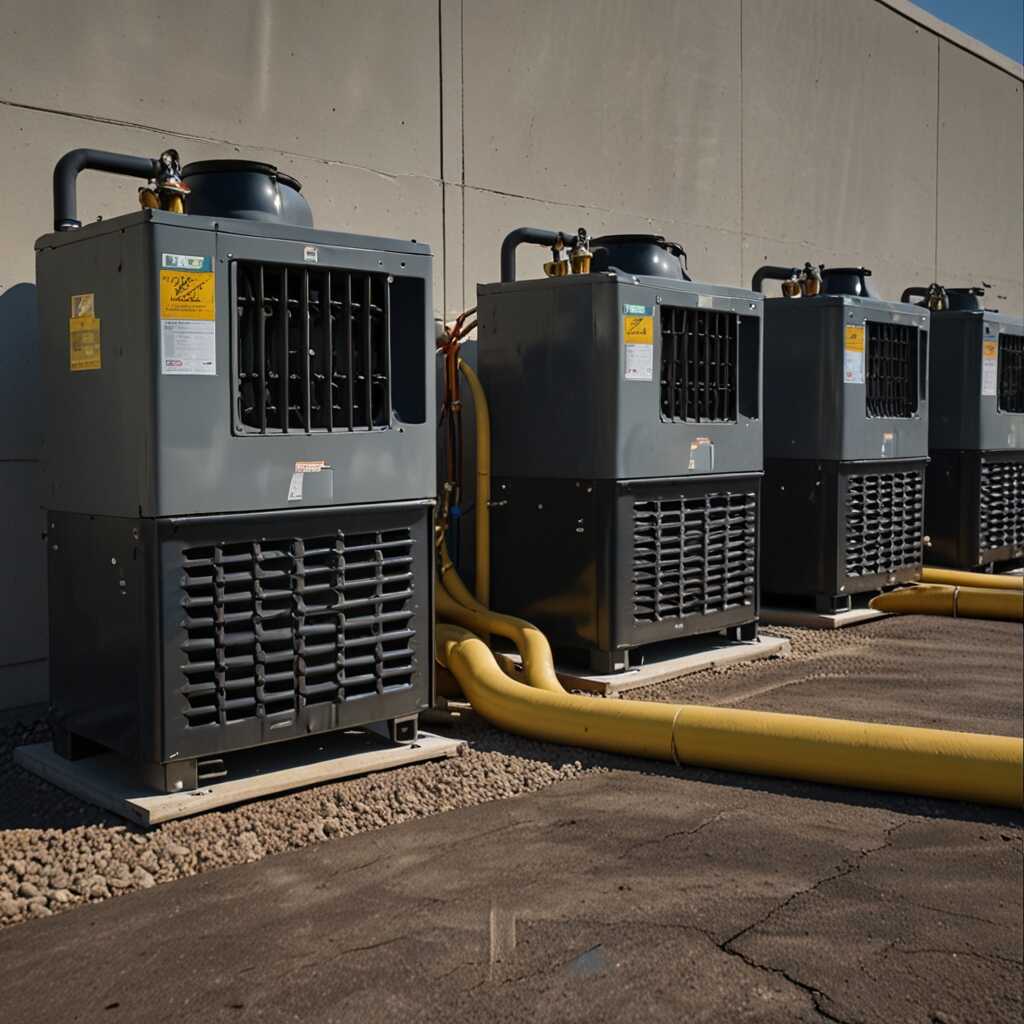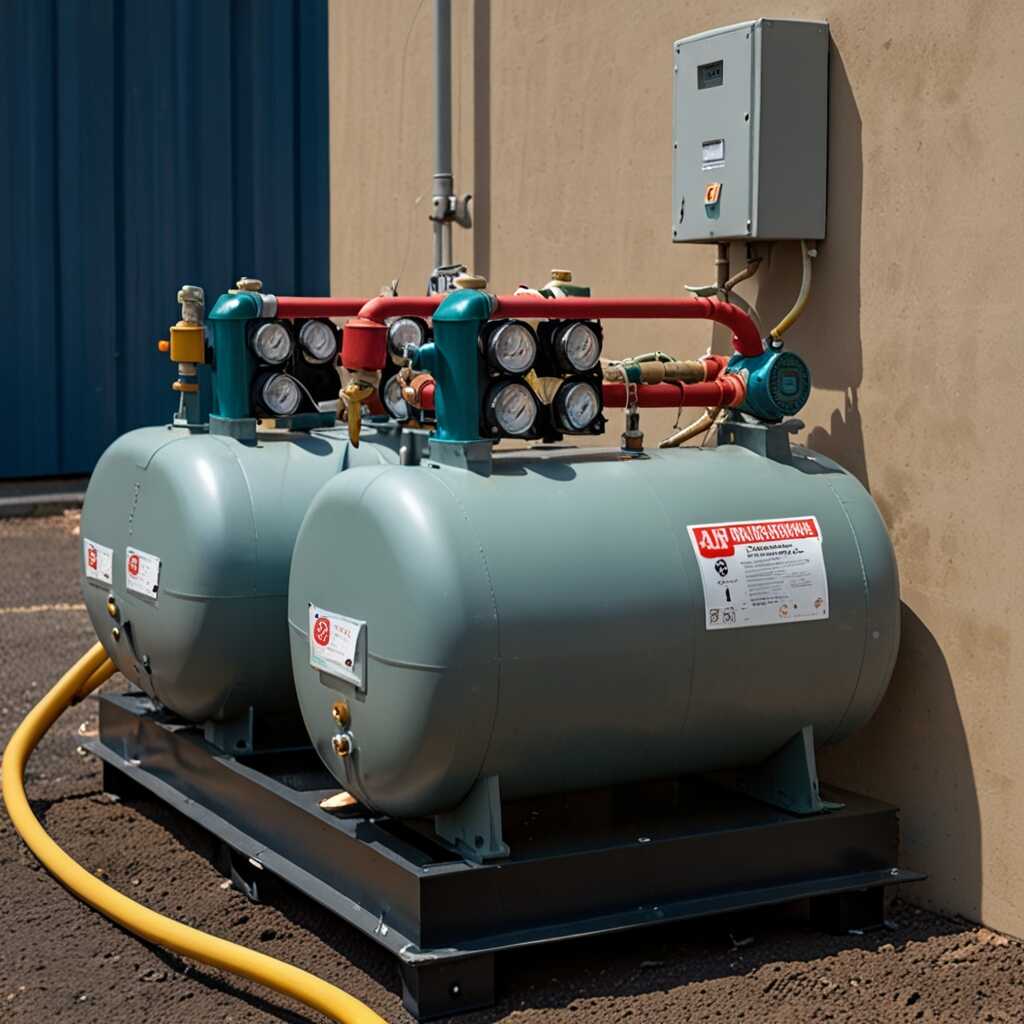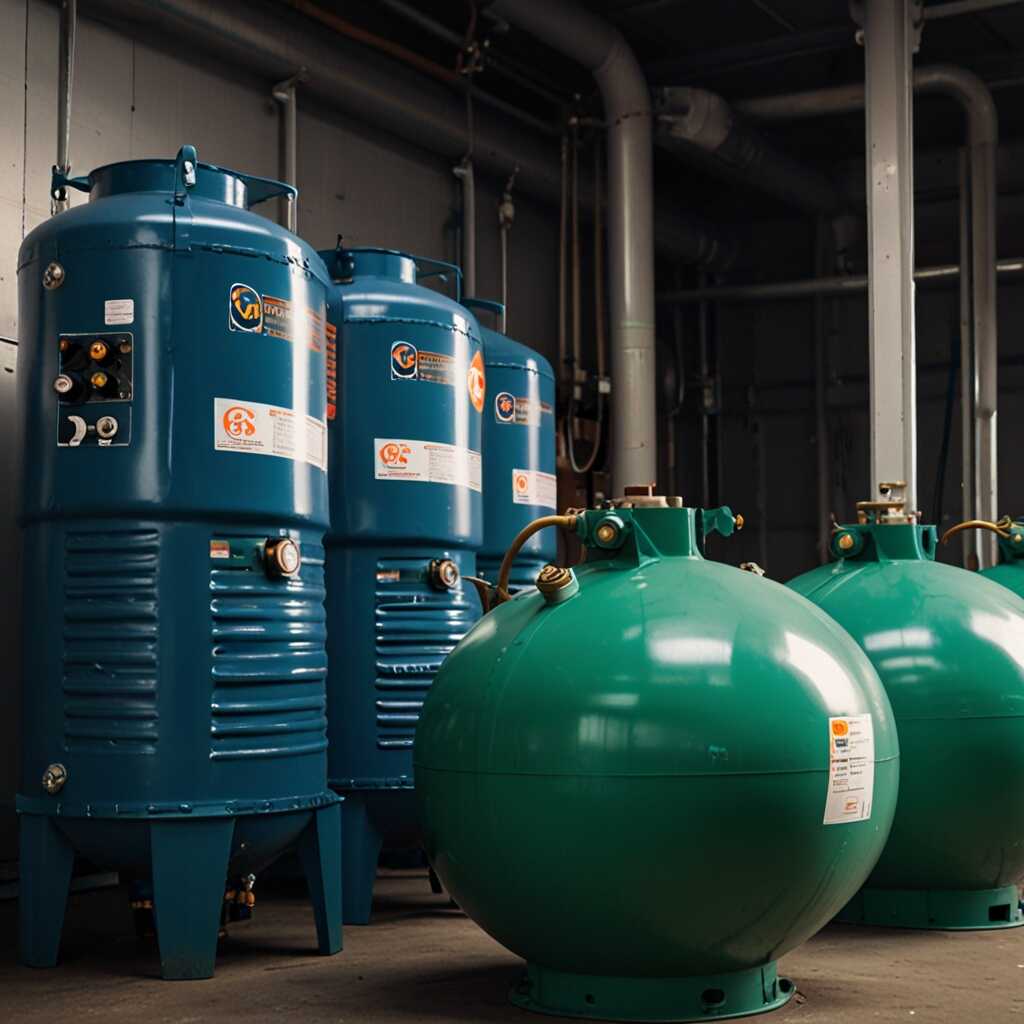The process of connecting multiple refrigerant recovery cylinders effectively is essential for large commercial HVAC projects. Properly linking these cylinders maximizes efficiency and ensures compliance with safety regulations. Refrigerant Recovery Pro offers technical advice and best practices to help HVAC technicians and facility managers tackle this complex task. Our expertise in refrigerant recovery methods guarantees that you will manage refrigerant safely and efficiently throughout your projects.
Overview of Refrigerant Recovery Cylinder Functions and Types
Refrigerant recovery cylinders play an essential role in HVAC systems. They capture refrigerants removed from equipment, ensuring safe disposal or recycling. Understanding the different types of refrigerant recovery cylinders enhances connections during large commercial HVAC projects. The most common types include DOT cylinders and recovery tanks, which differ in design and pressure ratings. These cylinders can handle various refrigerant types, including R-410A, R-22, and R-134A, thereby providing reliability and efficiency in recovery processes. Most cylinders can handle up to 30 pounds of refrigerant safely, which is crucial for maintaining compliance with environmental regulations.
Key Features of Refrigerant Recovery Cylinders
The key features of refrigerant recovery cylinders directly influence their performance in commercial HVAC applications. Many cylinders come equipped with safety relief valves. These valves prevent overpressure and ensure safe operation during recovery. Additionally, cylindrical shapes enhance stability and portability. Users should always verify that their selected cylinders meet EPA regulatory standards to ensure proper refrigerant recovery. Maintaining proper testing schedules for these cylinders is essential for reliability and efficiency. Regular reviews and visual inspections help identify any wear or damage, ensuring safe and effective operation on the job site.
Significance of Correct Setup for Cylinder Recovery
Correct setup and connection of refrigerant recovery cylinders is essential for several reasons. First, improper connections can lead to safety hazards such as leaks and explosive failures, posing risks to technicians and the environment. Second, a well-designed connection enhances the reliability and efficiency of refrigerant recovery operations. Various methods of connecting cylinders exist, each with unique characteristics affecting performance and safety. Checking regulatory compliance standards is crucial to prevent costly fines and ensure safe operations. Research shows that optimal setups can significantly decrease recovery times while improving overall safety.
Recommended Practices for Safe Cylinder Connection
To ensure the reliable connection of multiple refrigerant recovery cylinders, follow industry best practices. Use high-quality hoses rated for refrigerant services to minimize the risk of leaks. Regularly inspect all connections for wear and potential faults. Implement pressure testing procedures to confirm the integrity of hoses and fittings before initiating recovery. Utilize manifold gauge sets that can easily handle multiple cylinders, ensuring that each cylinder is accurately monitored during recovery. Following these guidelines will enhance efficiency and safety, allowing systems to operate effectively while minimizing the risk of hazards.

Essential Tools and Equipment for Cylinder Connections
HVAC professionals need specific tools for connecting multiple refrigerant recovery cylinders effectively. Essential tools include refrigerant recovery equipment, reliable connection tools, and multiple recovery hoses. Recovery hoses allow for quick connections between cylinders and help in removing refrigerant efficiently. It is crucial to select equipment designed for high efficiency and proven performance. Always ensure that the tools are durable and able to handle the high pressure associated with refrigerants. Additionally, professionals should regularly review and test their equipment to maintain reliability in performance.
Choosing Reliable Connection Tools for Optimal Performance
Choosing reliable connection tools enhances the efficiency of refrigerant recovery projects. Tools such as manifold gauges, quick connect couplings, and thermal relief valves are vital for optimal performance. Manifold gauges provide precise pressure readings, allowing technicians to monitor refrigerant levels effectively. Quick connect couplings streamline the connection process, saving time while ensuring a secure fit. Thermal relief valves help prevent pressure buildup, enhancing safety during recovery. Selecting high-quality tools improves the reliability of connections and ensures an effective refrigerant recovery process.
Key Statistical Insights for Connection Practices
- Two or more recovery cylinders can be handled simultaneously for efficient refrigerant transfer.
- A typical refrigerant recovery unit can process 5 to 10 pounds of refrigerant per minute.
- Using manifold gauges can increase recovery efficiency by up to 30%.
- Each recovery cylinder has a safe fill level, which should not exceed 80% of its capacity.
- Multiple tanks allow for the recovery of over 200 pounds of refrigerant without interruption.
- For every added cylinder, calculate an additional 0.5 hours for connection setup.
- Monitor ambient temperature; ideal recovery occurs between 60°F and 80°F.

Detailed Steps for Connecting Recovery Cylinders Safely
When connecting multiple refrigerant recovery cylinders, prioritize safety precautions. Use safety goggles and gloves. Ensure that the work area is well-ventilated. Check for leaks using a reliable leak detector. Essential tools for recovery include high-pressure hoses, fittings, and a valve manifold. Follow best practices by ensuring that all connections are tight. An efficient refrigerant recovery system can handle several cylinders, typically up to four cylinders connected simultaneously. This connection enhances the speed of recovery without compromising safety.
Essential Tools for Effective Cylinder Connections
To connect multiple refrigerant recovery cylinders effectively, use essential tools such as high-pressure hoses, specialized fittings, and a manifold gauge set. High-pressure hoses are designed for high-volume recovery, providing reliability during the transfer process. The fittings should match the threaded connections of your cylinders, ensuring a snug fit to prevent leaks. A manifold gauge set allows for testing cylinder pressure and controlling flow efficiently. These tools improve the overall efficiency and reliability of your refrigerant recovery operation, making large projects manageable.

Common Challenges and How to Overcome Them
Common challenges include improper connections, leaks, and limited cylinder capacity. Improper connections lead to refrigerant losses and increased costs. Employing proper connection techniques and reliable equipment enhances refrigerant recovery efficiency. For example, using compatible hoses and fittings is essential. Safety measures like pressure testing before use help prevent leaks. Regarding cylinder capacity, typically, you can connect up to five refrigerant recovery cylinders for effective recovery operations. This ensures functionality without exceeding system capabilities.
Essential Connection Techniques for Refrigerant Recovery
Utilizing essential connection techniques for refrigerant recovery enhances safety and performance during operations. First, always ensure all cylinders are rated for the refrigerant type. Use durable hoses designed for high-pressure situations to minimize leaks. Implement a manifold gauge set to monitor pressure levels. This helps ensure connections remain secure and performance is optimal. Integrating shut-off valves allows for easy handling of excess pressure. Each connection should also be double-checked for leaks before operation begins. Following these practices guarantees reliability and improves overall recovery success in HVAC projects.
Advantages of Using Multiple Tanks Simultaneously
- Enhances workflow efficiency, allowing for faster refrigerant recovery.
- Improves compliance with environmental regulations by minimizing gas venting.
- Allows for simultaneous recycling of different refrigerants when connected properly.
- Reduces downtime on large projects, keeping jobs on schedule and within budget.
- Lessens the need for frequent cylinder exchange on job sites, saving on transport costs.
- Increases technician productivity by enabling continuous operation with limited interruptions.
- Improves safety by lessening the risk of overfilling a single tank during recovery.

Understanding Regulatory Requirements for Recovery Processes
Key regulatory guidelines govern refrigerant recovery practices. The Environmental Protection Agency (EPA) outlines standards for refrigerant management under Section 608 of the Clean Air Act. Compliance is crucial to avoid penalties, especially during large HVAC projects. Regulatory bodies include the EPA, state environmental agencies, and local authorities. Their regulations dictate how refrigerants should be recovered, stored, and disposed of. Typically, commercial systems require the recovery of a minimum of 90% of refrigerant. Understanding these guidelines ensures reliability and helps maintain compliance and efficiency in recovery processes.
Critical Regulatory Bodies for Refrigerant Recovery Compliance
The EPA, along with state and local agencies, plays a crucial role in enforcing refrigerant recovery compliance. The EPA regulates the use and disposal of refrigerants, ensuring minimal impact on the environment. Their regulations are designed to enhance the reliability of refrigerant recovery. Technicians must regularly review guidelines to stay compliant. The EPA’s regulations set specific recovery standards, such as the requirement to recover 90% of refrigerant during system repairs. Keeping abreast of these regulations can help HVAC professionals enhance their operational efficiency and effectiveness while avoiding potential fines.
Implementing Best Practices for Successful Recovery Projects
Connecting multiple refrigerant recovery cylinders requires careful consideration of several key components. First, ensure that each cylinder is rated for the refrigerants being reclaimed. Use proper hoses designed for refrigerant transfer and check connections for leaks before starting. Implement a manifold system to facilitate the flow of refrigerants between cylinders. Effective pressure management is essential for reliable operation. Compliance with EPA regulations is also critical; HVAC professionals must ensure all procedures meet legal standards. Understanding the capacity limits of your equipment can help improve efficiency. Ideally, you can connect two to four cylinders to enhance the recovery process without overloading your system.
Choosing the Right Equipment for Cylinder Connection
Selecting the appropriate equipment significantly enhances the efficiency of refrigerant recovery. Use high-quality, durable hoses specifically designed for refrigerants to reduce the risk of leaks. Ensure that the manifold used can handle multiple cylinder connections without compromising performance. Equipment that features pressure gauges also helps monitor the system’s efficiency. Incorporate reliable shut-off valves for safety and quick disconnection. Investing in equipment with proven reliability ensures that your refrigerant recovery operations achieve excellent results while maintaining regulatory compliance.
Popular Brands and Their Key Features
- Yellow Jacket: Known for durable construction, their recovery units are ideal for heavy-duty usage.
- Appion: Offers lightweight and portable units, making it easy to transport across job sites.
- Fieldpiece: Provides advanced diagnostics, aiding in troubleshooting during the recovery process.
- Ritchie Engineering: Features user-friendly interfaces, simplifying operation for less experienced technicians.
- Mastercool: Combines affordability with efficiency; great for small shops needing budget solutions.
- RecoverX: Targets large industrial applications; ideal for managing high-capacity recovery tasks.
- Enviro-Safe: Focused on environmentally friendly options, suitable for businesses needing green solutions.
Accessing Further Resources and Professional Support
To improve reliability in refrigerant recovery, HVAC professionals should access a variety of resources. The FAQ section on Refrigerant Recovery Pro provides answers to commonly asked questions. Experts recommend joining industry organizations like the HVACR contractors and the Air Conditioning Contractors of America for expert guidance. Additionally, participating in training sessions at least annually can help professionals stay updated with the latest regulations and best practices.
Finding Technical Support Services for Refrigerant Recovery
Finding reliable technical support services is essential for maximizing efficiency in refrigerant recovery. Refrigerant Recovery Pro offers expert advice through their knowledge base and customer support channels. You can reach out to them via email at technical@refrigerantrecoverypro.com for specific technical inquiries. They provide detailed reviews and comparison articles to help technicians select the right equipment for their projects. Utilizing these support services enhances your operational efficiency and ensures compliance with industry standards.